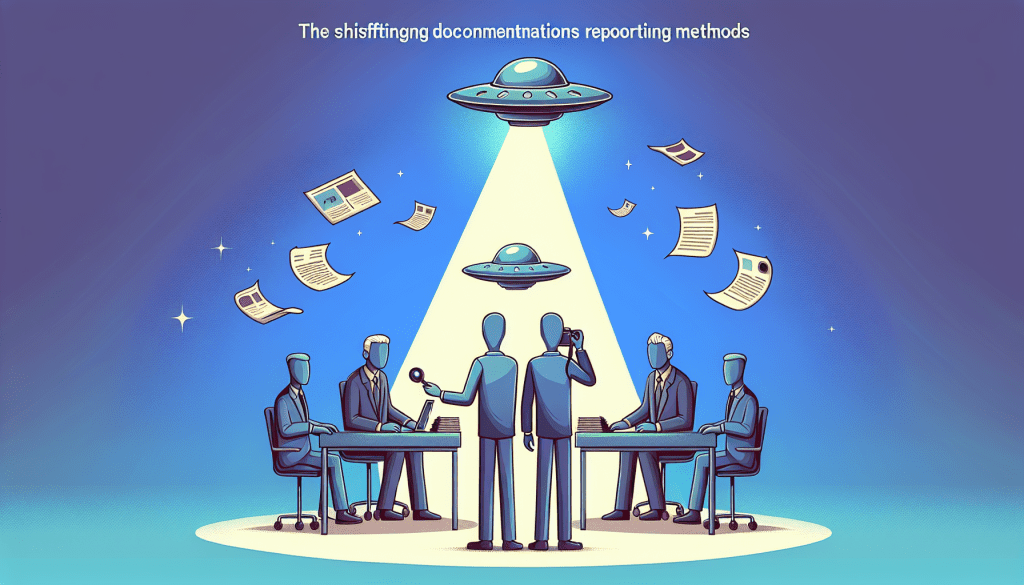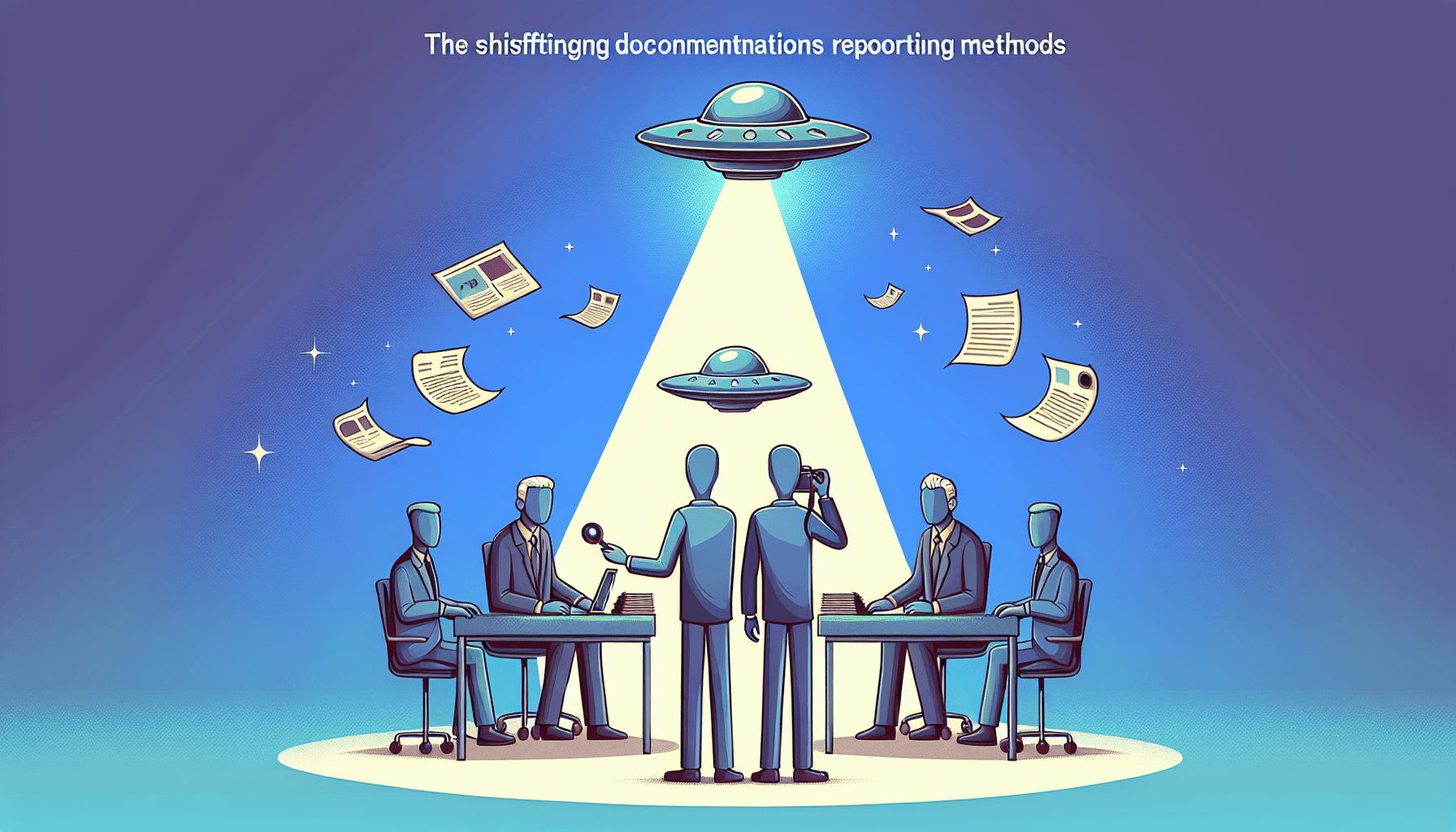Have you ever wondered how people have reported UFO sightings throughout history? In this article, we will take a look at the fascinating evolution of UFO sighting reporting methods. From handwritten letters and phone calls to modern-day online platforms, the way people share their encounters with unidentified flying objects has transformed over time. Join us as we explore the different ways that individuals have documented and reported UFO sightings, and how these methods have evolved to keep up with changing technology.

Early Reports
Astronomical Observations
In the early days, when civilization was just beginning to explore the skies, UFO sightings were often attributed to astronomical observations. Observations of comets, meteors, and other celestial phenomena were often misunderstood and reported as unidentified flying objects. Many ancient civilizations, such as the Egyptians and the Greeks, documented these sightings and incorporated them into their mythologies and folklore.
Folklore and Mythology
As UFO sightings were not yet understood scientifically, they became intertwined with folklore and mythology. Ancient cultures around the world attributed these sightings to supernatural beings, gods, or other mythical creatures. These stories were passed down through generations, and the sightings were often perceived as significant events that held deep spiritual or religious meanings.
Pre-Modern Era
Before modern technology and the scientific method took hold, UFO sightings were often dismissed or explained away as religious or supernatural events. In the pre-modern era, there were limited means of documenting and reporting such sightings, making it difficult to gather reliable data. Despite the lack of concrete evidence, these sightings continued to captivate the imagination and curiosity of people throughout history.
The Birth of Modern UFO Sightings
The Kenneth Arnold Sightings
The birth of modern UFO sightings can be traced back to June 24, 1947, when private pilot Kenneth Arnold reported seeing a formation of nine strange, high-speed objects near Mount Rainier, Washington. Arnold described the objects as saucer-like and coined the term “flying saucers,” which quickly gained media attention and sparked public interest in UFOs.
Roswell Incident
One of the most famous UFO incidents occurred in Roswell, New Mexico, in 1947. An unidentified object crashed near Roswell Army Air Field, leading to widespread speculation and conspiracy theories about extraterrestrial spacecraft. The incident sparked debates, investigations, and fuelled the belief that the government was involved in a cover-up of possible alien encounters.
Pilot Reports
Pilots have always been regarded as credible witnesses due to their training and experience in the aviation field. Many pilots have reported encountering unidentified flying objects during their flights, often describing them as unconventional aircraft or objects with extraordinary capabilities. These pilot reports have contributed to the growing interest and legitimacy of UFO sightings.
Government and Military Involvement
Project Blue Book
In 1952, the U.S. Air Force initiated Project Blue Book, a program dedicated to the scientific study of UFOs. Over the course of 17 years, Project Blue Book collected and analyzed thousands of reports, aiming to determine whether UFOs posed a threat to national security. Although the project concluded that most sightings could be attributed to natural events or misidentifications, some cases remained unexplained, fueling further speculation.
The Condon Committee
In the late 1960s, the U.S. Air Force commissioned the Condon Committee, led by physicist Edward Condon, to conduct a comprehensive scientific study on UFOs. The committee’s final report, released in 1969, concluded that further investigation of UFOs was unwarranted, and the scientific community should not pursue the study of UFOs. This report had a significant impact on the perception of UFO sightings within the scientific community.
Black Projects and Cover-ups
Conspiracy theories suggesting government involvement and secrecy surrounding UFOs gained significant traction over the years. Alleged black projects, underground programs, and top-secret experiments fueled speculation that governments around the world were studying and suppressing information about UFO sightings. These theories still persist today, contributing to the ongoing mystery and fascination surrounding UFOs.
UFO Organizations and Research Groups
National Investigations Committee on Aerial Phenomena (NICAP)
Formed in 1956, NICAP was one of the first organizations dedicated to the investigation and research of UFO sightings. NICAP gathered reports, conducted investigations, and advocated for government transparency on the UFO phenomenon. Their work helped bring credibility to UFO research and encouraged more witnesses to come forward with their accounts.
Mutual UFO Network (MUFON)
Established in 1969, MUFON became one of the largest and most well-known organizations focused on UFO investigations. MUFON’s mission was to promote the scientific study of UFOs, provide a platform for witnesses to report sightings, and gather and analyze data. Through their efforts, MUFON has contributed to the collection and documentation of thousands of UFO sightings worldwide.
Center for the Study of Extraterrestrial Intelligence (CSETI)
CSETI, founded by Dr. Steven Greer in 1990, takes a unique approach to UFO research by focusing on establishing peaceful contact with extraterrestrial civilizations. CSETI conducts field investigations, gathers witness testimonies, and promotes the study of consciousness and advanced energy technologies. Their work aims to shift the focus from fear and mystery to understanding and communication with potential intelligent life beyond Earth.
Scientific Approaches and Studies
Hynek’s Classification System
Dr. J. Allen Hynek, an astronomer and consultant for Project Blue Book, developed a classification system to categorize UFO sightings based on witness descriptions. The system included Close Encounters of the First, Second, and Third Kind, which distinguished sightings of visual encounters, physical effects, and interactions with occupants. Hynek’s classification system continues to be widely used and referenced in UFO research today.
Statistical Analysis of UFO Sightings
To better understand patterns and trends in UFO sightings, researchers have employed statistical analysis techniques. By analyzing thousands of reports, researchers can identify common characteristics, such as time of day, geographical locations, and shapes of observed objects. These analyses contribute to a more systematic and data-driven approach to studying UFO sightings.
Radar and Physical Traces
In some cases, UFO sightings are accompanied by radar data and physical evidence left behind, such as crop circles or trace elements. Radar data can provide additional corroborating information about the presence and behavior of unidentified objects. Physical traces, when carefully analyzed, can offer tangible evidence that something unusual occurred, prompting further scientific investigation.
The Digital Age and Online Reporting
UFO Websites and Online Forums
With the rise of the internet, UFO enthusiasts and witnesses gained a platform to share their experiences and discuss sightings on dedicated websites and online forums. These platforms provided a space for collaboration, information exchange, and support among individuals interested in UFOs. Witness testimonies and photographic evidence became more accessible to a wider audience.
Mobile Apps and Social Media
The advent of smartphones and social media platforms further revolutionized UFO reporting. Mobile apps dedicated to tracking and reporting sightings emerged, allowing witnesses to quickly document and submit their observations. Social media platforms provided a real-time and interconnected space for individuals to share and discuss UFO sightings, amplifying their reach and influence.
Crowdsourcing and Data Analysis
The digital age enabled a new approach to UFO research through crowdsourcing and data analysis. Platforms like UFO Stalker and NUFORC (National UFO Reporting Center) crowdsource sightings from individuals worldwide, allowing for comprehensive data collection. Researchers and data analysts utilize these databases to identify patterns and trends, contributing to a more scientific understanding of UFO sightings.
Academic Interest and Mainstream Media
Extraterrestrial Life and Astrophysics
The search for extraterrestrial life has gained momentum within the scientific community, with organizations like NASA actively exploring the possibilities of life beyond Earth. Astrobiology and the study of exoplanets have expanded our understanding of habitable zones and the potential for extraterrestrial civilizations. These scientific endeavors have influenced the academic interest in UFO sightings as potential evidence of alien encounters.
Journalistic Coverage and Documentaries
The mainstream media has played a significant role in shaping public perception and interest in UFO sightings. Numerous documentaries, movies, and TV shows have featured stories about UFO encounters and investigations, further fueling public curiosity. Journalists have also increased their coverage of UFO sightings, conducting interviews with witnesses and examining the scientific and societal implications of the phenomenon.
Academic Conferences and Research
Academic conferences focused on UFO research provide a platform for scientists, researchers, and enthusiasts to present and discuss their findings. These conferences promote rigorous scientific methods and encourage interdisciplinary collaboration. Researchers from diverse fields, such as astronomy, psychology, and sociology, come together to share their perspectives and insights, contributing to a more comprehensive understanding of UFO sightings.
International Collaboration and Exchanges
UFO Sightings in Canada
Canada has a long history of UFO sightings, with numerous reports and investigations conducted by both government and civilian organizations. The Canadian government’s UFO research initiative, Project Magnet, and subsequent government-funded studies have contributed to the international collaboration and exchange of information regarding UFO sightings.
European UFO Research Network (EURN)
The European UFO Research Network was formed to facilitate collaboration and information sharing among European countries involved in UFO research. By combining resources and expertise, EURN aims to promote scientific investigation, exchange data, and establish standardized methods for collecting and analyzing UFO sighting reports. This international cooperation enhances the quality and reliability of UFO research.
International Mutual UFO Network (IMUFON)
IMUFON serves as a global network of diverse UFO research organizations, fostering collaboration, data sharing, and joint investigations. Member organizations from around the world work together to analyze and interpret UFO sighting data, exchange knowledge, and promote rigorous scientific approaches. This international network contributes to the credibility and advancement of UFO research on a global scale.
UFO Sightings in Popular Culture
Movies, Books, and TV Shows
UFO sightings have captured the imagination of filmmakers, authors, and TV producers, resulting in a plethora of movies, books, and TV shows dedicated to the subject. From classic films like “Close Encounters of the Third Kind” to popular TV series like “The X-Files,” these portrayals have not only entertained audiences but have also shaped public perception and contributed to the fascination with UFO sightings.
Famous UFO Sightings
Certain UFO sightings have gained iconic status and become deeply embedded in popular culture. The sighting of an alleged flying saucer in Roswell, the Phoenix Lights incident, and the Hill abduction case are just a few examples of famous UFO encounters that continue to capture public attention. These cases have been extensively studied, debated, and referenced in various forms of media, furthering their significance in popular culture.
Affect on Society and Beliefs
UFO sightings have had a profound impact on society and the beliefs of individuals worldwide. While some people remain skeptical, countless others believe that UFO sightings are genuine encounters with extraterrestrial life or advanced technology. These beliefs shape personal worldviews, influence cultural narratives, and spark debates about the existence of intelligent life beyond Earth. The societal implications of UFO sightings continue to be a subject of fascination and discussion.
Challenges and Debunking of UFO Sightings
Psychological Explanations
Psychologists and neuroscientists have proposed various psychological explanations for UFO sightings. Factors such as pareidolia, which is the tendency to perceive familiar patterns in random stimuli, and sleep-related hallucinations, known as hypnagogic and hypnopompic experiences, can contribute to the perception of UFO encounters. Psychological research helps shed light on the human mind’s role in interpreting and experiencing UFO sightings.
Misidentifications and Hoaxes
UFO sightings can often be attributed to misidentifications of conventional phenomena, such as aircraft, satellites, balloons, or atmospheric phenomena like ball lightning. Hoaxes and intentional fabrications also contribute to the prevalence of false UFO reports. Through careful investigation and analysis, researchers aim to differentiate between genuine sightings and misidentifications or hoaxes, ensuring more accurate and reliable data.
Skepticism and the Scientific Method
Skepticism plays a crucial role in the scrutiny and analysis of UFO sightings. The scientific method encourages researchers to approach UFO reports with skepticism, considering alternative explanations and seeking out empirical evidence. By subjecting UFO sightings to rigorous investigation and analysis, researchers can separate genuine unidentified aerial phenomena from misinterpretations, misidentifications, or deliberate fraud.
The evolution of UFO sightings reporting methods showcases humanity’s enduring fascination with the unknown and the potential for extraterrestrial life. From ancient folklore to modern scientific approaches, the study of UFO sightings has evolved, adapting to advancements in technology, changing societal attitudes, and growing academic interest. As technology and research continue to progress, the quest for answers regarding UFO sightings persists, pushing us closer to unraveling the mysteries of the universe and our place within it.

